Some travel to the Kenai Fjords to stand on the bow of a boat beside the glaciers. Some come to experience the sound of a whale’s breath as it rises to the surface of the sea. Some visit for the sea otters, or for rocky islands green against the sky, or for mountains that rise sheer-sided from waters emerald-colored with life.
But for a select few, the mountains and glaciers and whales are all mere accompaniments to the true wealth of Kenai Fjords National Park: the birds.
For birders looking to stretch their life list, Alaska is an easy choice. With over a thousand miles as the jaeger flies between the Kenai Peninsula and the Lower 48, we have the distance needed for an entirely new set of avian species. Some of the birds we see, such as red-faced cormorants, kittlitz’s murrelets, and parakeet auklets, cannot be seen on tours any further south or east. And with a home port in Seward, Major Marine Tours is just a bus or a train ride away from the Anchorage airport, meaning your life list species are easily within reach.
As with any wildlife viewing, no sightings are ever a guarantee. However, all of our captains bring years of experience working on the water with Major Marine Tours, and our captains and crew are experts at knowing the precise places frequented by each type of bird. Nesting areas, rookeries, habitually rich feeding grounds — these are the areas we visit each and every day, and will use all of our tricks to get you the best possible chance at finding your life list birds.
So who are the birds of the Kenai Fjords? Let’s take a moment to get to know our avian superstars.
The holy grail of birds in the Kenai Fjords region, the kittlitz’s murrelet can be seen in only a few places in the distant Northwestern Fjord. These murrelets occupy a very narrow range of habitats, traveling from their nests on scree-covered slopes to feed at the base of tidewater glaciers. As the waters that these birds frequent are among the most inaccessible in the National Park, Major Marine Tours’ 8.5 hour cruise is your best option to reach these animals in the least-traveled Northwestern Fjord. The captains and crew that run the 8.5 Hour Northwestern Fjord Cruise travel to this remote area daily, and so are intimately acquainted with the areas that will give you your best chance to see the kittlitz’s murrelet in its glacial habitat.
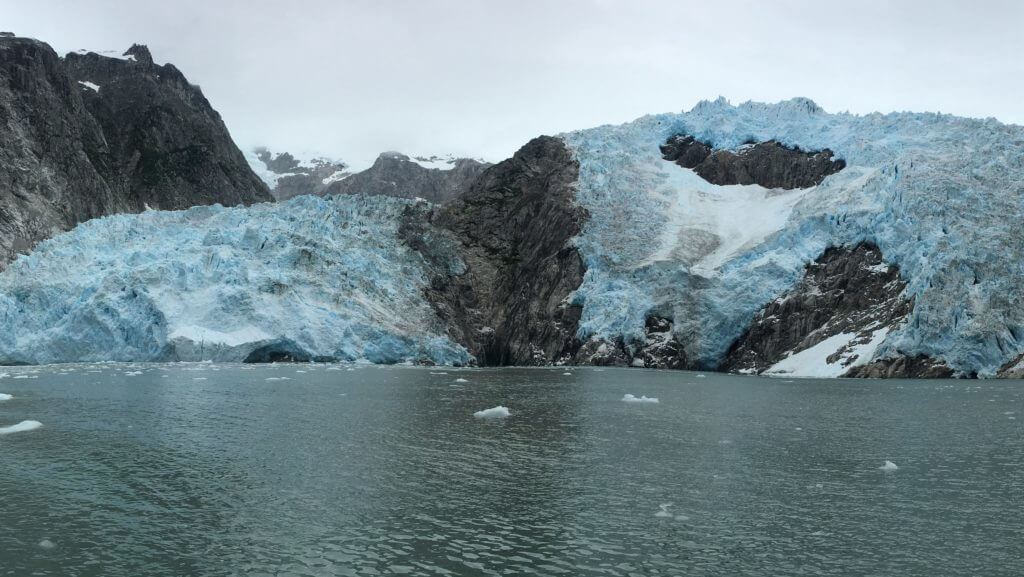
Three species of cormorants call the Kenai Fjords area home: the pelagic cormorant, the double-crested, and, rarest of all, the red-faced cormorant. With a metallic green sheen in the sunlight, a bright white flank patch, and photogenic red around the face, the red-faced cormorant brings a splash of color to the coast. The Kenai Fjords are among the furthest eastward range of this species, meaning that a tour out of Seward is your most strategic place to see our most charismatic cormorant.
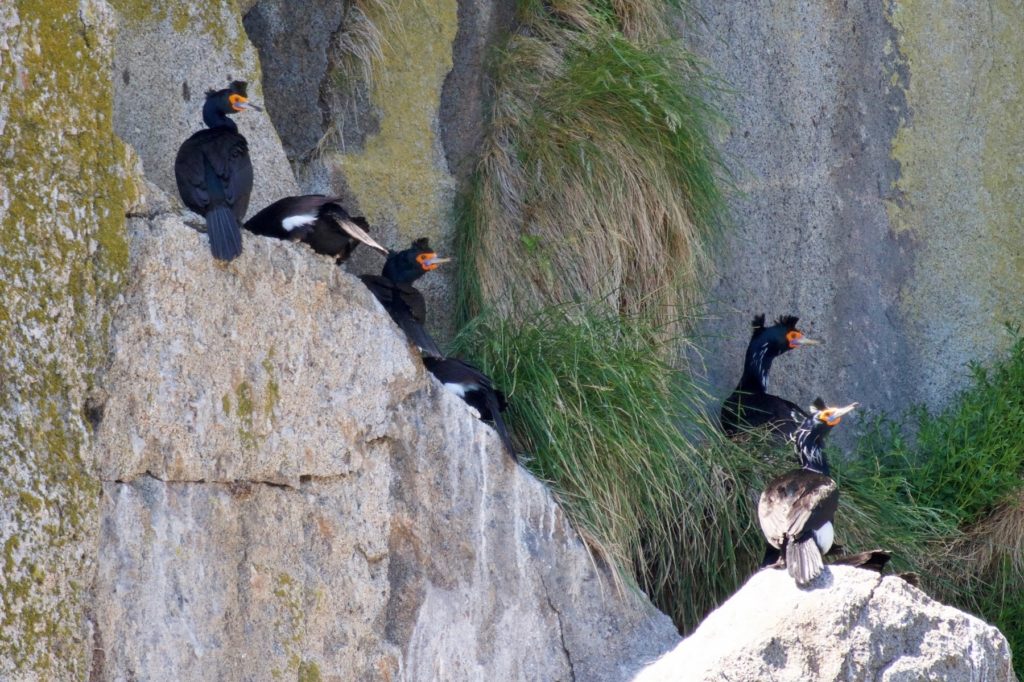
It is impossible not to be delighted with the parakeet auklets, with their wide white eyes, round red bills, and characteristic white plume. Named for calls which are reminiscent of the chatter of parakeets, these auklets are one of our more melodic seabirds. There are only a few precise places where parakeet auklets can be found, but luckily, our captains know exactly where to look! And unlike other tours, the 8.5 hour Northwestern Fjords Cruise will travel each and every day through the island hotspots where these birds are most frequently seen.
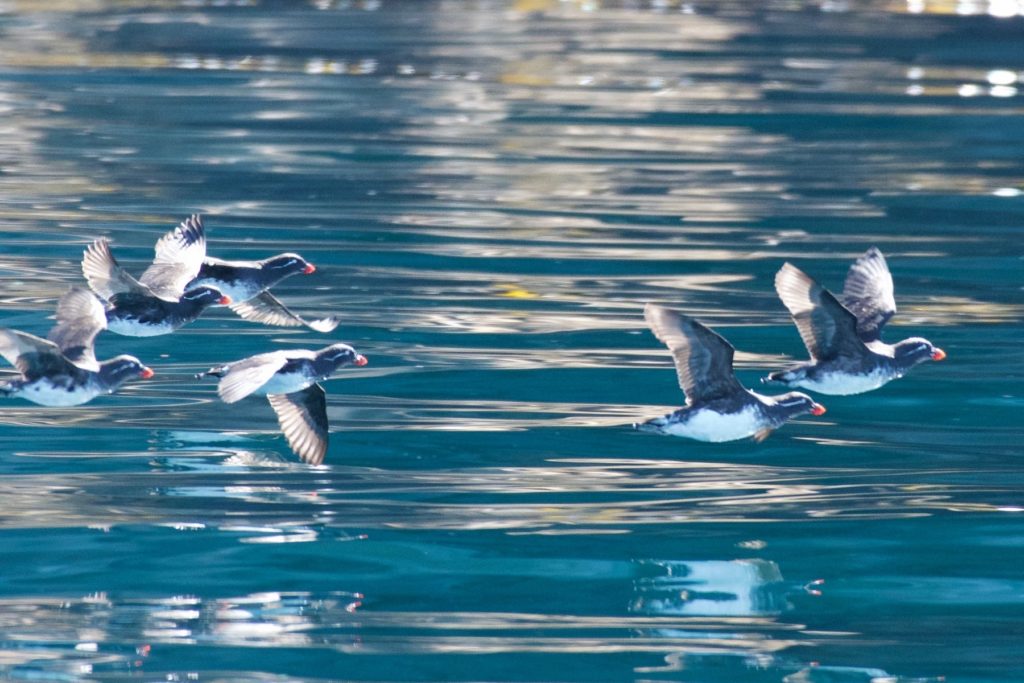
Heftier than other auklets, rhinoceros auklets are often considered the fourth species of puffin. With their characteristic “horn,” dusky body, and white face plumes, these birds are easily picked out from the crowds of feeding puffins. As rhinoceros auklets only return to their nests are night, they spend their days feeding and resting and so can be sought on the water as we travel across Aialik Bay and into Harris Bay. And when else will you get the chance to tell your friends you saw a rhino in Alaska!
Common murres are easy to see rafting on the water or standing penguin-like on rocky ledges, but harder to spot are the thick-billed murres in their midst. Barely distinguishable from the common murre, with a thin white line on their upper bill and a slightly darker black body, these birds are an elusive challenge for the accomplished birder.
Another hard-to-find species, ancient murrelets are anything but predictable! Best seen in open water, these birds have a white “eyebrow” that grants them a wizened appearance and easily distinguishes them from marbled murrelets. Look quickly, though, because ancient murrelets have a habit of diving straight from flight beneath the waves!
As you will know if you are a frequenter of wildlife tours, rarely can any sightings be guaranteed. However, summers in Kenai Fjords are a frenzy of puffins, and so if puffins are what you seek you will rarely be disappointed! Throughout June and July and into the first weeks of August, horned puffins and tufted puffins abound. On the water, puffins rest at the surface before dipping below in search of fish, while on the islands above, horned puffins peer from rocky crevices and tufted puffins stand guard over their grassy burrows. Some islands are even known as the “beehive” islands for the tufted puffins that circle the skies as thick as bees around a hive. Puffins are the classic personalities of the water, brightly colored and as awkward above the water as they are graceful below. And if you can’t get enough of puffins after your trip, I highly recommend a visit to the Alaska Sealife Center in Seward, where a special exhibit allows you to watch puffins “fly” underwater.
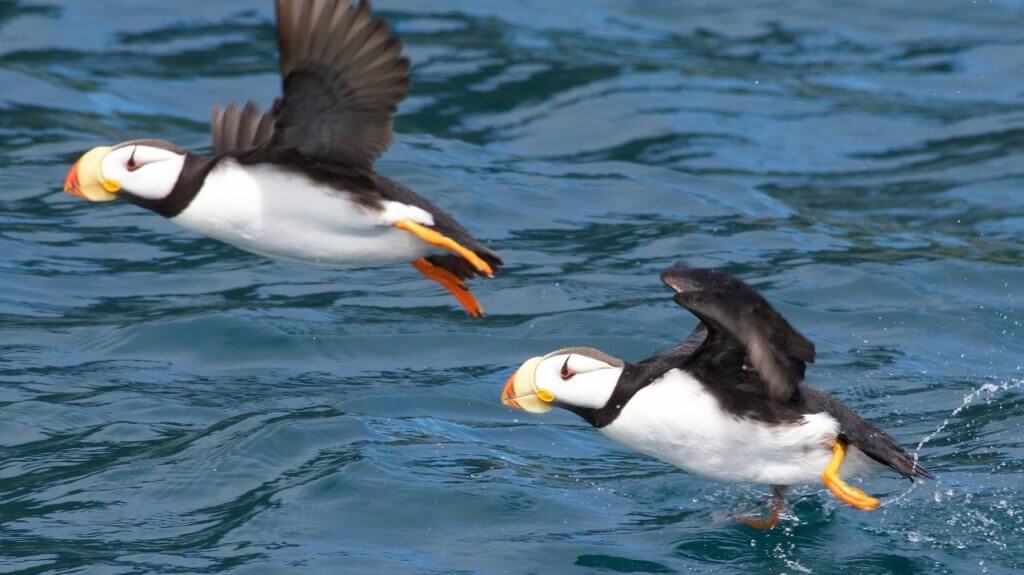
Of course, no seascape would be complete without gulls, and the Kenai Fjords is no exception. Flocks of black-legged kittiwakes circle above bait balls, the larger glaucous-winged gulls in their midst. One of my favorite experiences in the fjords is to watch kittiwakes move as one entity, peeling off of their cliffside nests or pouring towards a bait ball on the surface. If this behaviour happens above a rookery, look up — often kittiwakes will peel off the cliffs in response to an eagle or peregrine falcon above. And as the season progresses in July and early August, train your binoculars on those nests: sometimes a grey kittiwake chick or a fuzz-brown glaucous-winged chick can catch you by surprise!
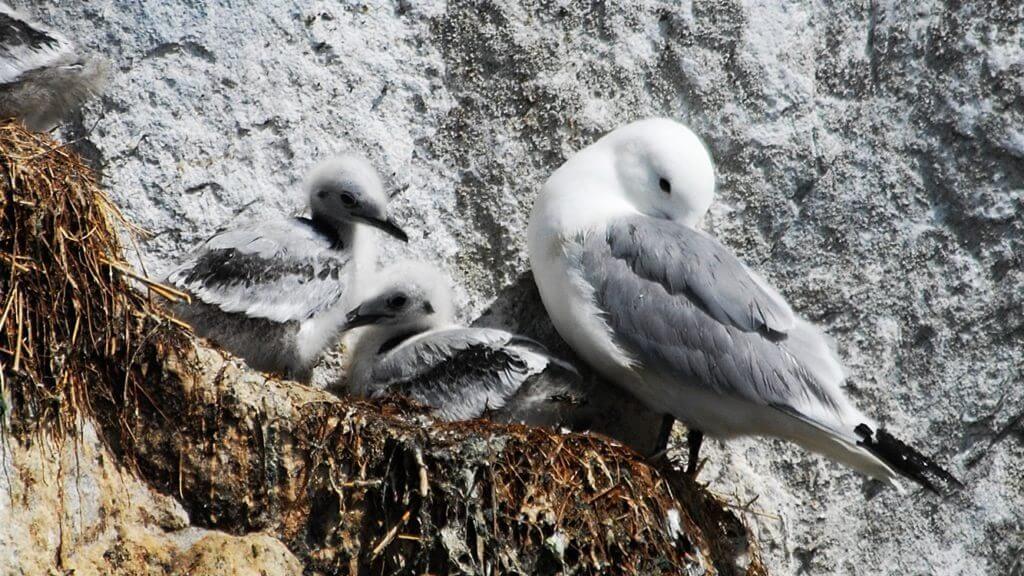
All of our trips to tidewater glaciers will travel briefly through the Gulf of Alaska, an area that is heavily influenced by ocean storms, but in the case of birding, the worst weather is actually the best weather! With storms come wind, and with winds come the rarely-seen inhabitants of the open ocean. Sooty shearwaters arrive with rough weather, having traveled all the way from the southern hemisphere to feed in the open water, and pomarine or parasitic jaegers will sometimes make an appearance. When the weather truly thickens, northern fulmars and even the rarely-seen storm petrels are a possibility. So if you hear that the weather looks rough, pick up some bonine from our check-in staff and enjoy a rare chance at pelagic birding!
And of course, no post about birding in the Kenai Fjords would be complete without a few tips on how to increase your chances of seeing as many birds as possible:
As we travel across open water, we’ll often encounter birds that fly past and continue on their path faster than we can follow, which means you’ll want to be out and ready to take advantage of these on-the-wing sightings. Sometimes we’ll only have a few seconds with these birds, but if you’re ready that can be enough time for a quick photo or a new ID!
The more you know about key ID features, the more quickly you’ll be able to identify birds in the field. If you can know the difference between marbled murrelets or kittlitz’s murrelets, red-faced cormorants or pelagic cormorants, and common murres or thick-billed murres, then you’ll be well situated to make the most accurate field identifications.
Due to the smaller group size on our Northwestern trip, our captains and crew are better able to customize our trips for the passengers we have onboard that day. If you are interested in any particular bird, then let us know at the start of the trip and we’ll do what we can to plan our trip so that you have the best chance at seeing those species.
I may sound like a broken record, but the 8.5 Hour Northwestern Fjord Cruise is the best possible trip for seeing the most possible bird species. This is the only cruise that passes through the birding hotspot of the Chiswell Islands each and every day, and this is the only cruise that goes to Northwestern Fjord, the most consistent place to see kittlitz’s murrelets. The captains and crew that drive this trip are among our most experienced birders, and have spent years getting to know the area and all of its wildlife hotspots. And due to the smaller number of passengers on this trip, we are better able to arrange the trip to ensure that you get the best chance at your life list birds.
And the last thing I’d like to say is hello. Who knows – maybe I’ll see you out there.
Happy Birding!
Tamara Lang is a senior deckhand with Major Marine Tours in Seward. She is a writer of creative nonfiction and the author of “Upstream: A Written and Photographic Journey up the Los Angeles River.” Her writing and her travels can both can be followed on facebook at Tamara Lang Writes, or at tamaralang.com.
Signup for our newsletter to get the most recent Major Marine updates.